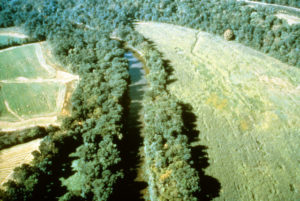
Riparian buffer (Image via USDA National Agroforestry Center)
A group of trees lining a babbling brook does more than make an idyllic picture.
“It filters out nutrients, it holds soil in place, it adds shade when the trees have canopy to streams, and controls water temperature,” says Alysha Trexler with the Western Pennsylvania Conservancy.
She says excess fertilizer from farm fields, dirt from rural roads, and even pollution from urban streets can wash into streams when it rains. But tree roots can help filter out some of that pollution before it ends up in waterways.
“So it’s important that this is in place for all areas,” Trexler says. “All streams and waterways need a healthy riparian area which includes the trees and shrubs.”
Hear Alysha Trexler talk more about riparian buffers:
Get Schooled:
- Learn more about riparian buffers from Penn State Extension.
- Check out this fact sheet from the Pennsylvania DCNR.
- Take in some tips for helping streambank plantings succeed.
The fine print:
- This segment was produced in partnership with Cornell University’s Atkinson Center for a Sustainable Future and made possible by the Foundation for Pennsylvania Watersheds.




